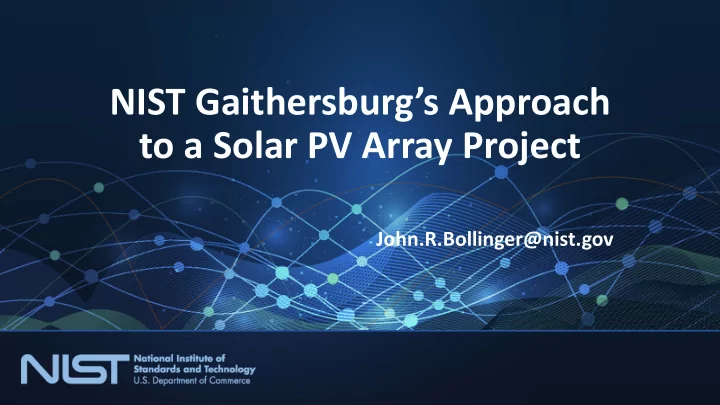

NIST Gaithersburg’s Approach to a Solar PV Array Project John.R.Bollinger@nist.gov
2
NIST had awarded larger ESPC ($45M) with 4 ECMs the previous year (June 2015) Non-selected ECM was fixed-tilt, ground-mounted solar array on federal property ⁻ Project’s forecasted cash flow wouldn’t payback within 25 years ⁻ Principal solar array developer was sub-ktr to overall prime ESCO; prime’s O/H and profit too much burden unless NIST provided 7-digit upfront cash infusion
Tried a year later as stand-alone ECM using ENABLE; avoids tacked-on O/H and profit burden ⁻ Issued NOO using GSA Federal Supply Schedule 84, SIN 246-53 {now Multiple Award Schedule SIN 334512} ⁻ Initially only pursued government ownership option: NIST owns and responsible for O&M, repair/replacement costs after project is commissioned and accepted ⁻ No need for Preliminary Assessment with ENABLE process ⁻ Price was most important evaluation criteria – 65% 4
Had 4 separate GO – NO GO criteria: ⁻ Safety (EMR) rating of 1.0 or less ⁻ Proof of experience on PV systems larger than 1 MW in size ⁻ Attend (in person) on-site visit to NIST Gaithersburg campus ⁻ Offer an “all-in” unit electric rate < 10 cents/kWh, which was rate NIST currently paying to local utility 5
Six ESCOs submitted bids 5 of 6 rec’d GO on each of 4 criteria; Safety was downfall for 6 th ESCO Price evaluation - lowest unit rate; highest first year cost savings Written responses to 4 questions - past performance, management plan and structure, strengths, design/implementation team 6
Clear cut who to choose as down selected ESCO and move forward to IGA phase; offered all-in unit rate was 15% lower Hold the presses – IRS publishes Revenue Procedure 2017- 19, providing new guidance regarding tax credits for private ownership option NIST was almost ready to proceed down gov’t ownership path when IRS 2017-19 was issued; NIST chose to explore both gov’t and private ownership options 7
Remaining 5 ESCOs queried – submit price component for private ownership option given new IRS guidance, or only interested in gov’t ownership? 4 ESCOs provided private ownership all-in unit rate; one declined 4 offers evaluated again against price criteria – lowest unit rate, highest first year cost savings 8
Clear cut again who to choose as down selected ESCO to move forward to IGA phase; offered unit all-in rate was 40% lower than what NIST was currently paying local utility provider ESCO with best gov’t ownership offer compared against ESCO with best private ownership offer 9
All-in unit electric rate: ⁻ Government ownership – 8.5 cents ⁻ Private ownership – 5.9 cents (31% lower than gov’t ownership option) First Year and Life cycle cost savings: ⁻ Government ownership - $98K and $1.56M (adjusted to $4.08M for 20 years) ⁻ Private ownership - $304K and $5.98M (210% and 47% higher than gov’t ownership option) 10
ESCO that offered best private ownership option continued on in the process to conduct IGA Normal process – IGA received, SOW reviewed/finalized in partnership with ESCO, Final Proposal, allowable price adjustments negotiated, and lastly contract award (Advice – if price is primary evaluation factor, request ESCOs include information in their NOO responses regarding how the market and other changes (such as SREC prices) will impact their final unit price offered in IGA.) 11
Final unit price – 7.1 cents; impacts of solar panel tariff, SREC market, utility connection requirements raised the original IGA offered rate of 5.9 cents Timeline – kicked-off July 2016; awarded May 2018; operational December 2018 (Advice – engage NREL and DoE/FEMP subject matter experts; use them actively throughout entire process. A wealth of useful help.) 12
In the end, private ownership 31% cheaper than gov’t ownership option Project size – 5 MW (DC); 15 acres; 11 football fields; 14,700 panels; $10.2M; provides 5.2% of NIST’s electric load 20-year contract term, contractor responsible for all operations, maintenance, repair, replacement costs Developed revocable, no-cost license agreement for non- federal use of NIST’s real property PV contractor gets tax credits (ITC, MACRS), solar REC credits 13
14
NIST purchases array at end of 20-year term at fair market value ⁻ Interim FMV appraisals at 5, 10, 15 years. Final appraisal at time of title transfer ⁻ All-in unit rate that ktr charges per kWh includes a reserve account payment. Total of account at end of 20 years = final appraised fair market value; so no additional funds needed ⁻ Projected 10 more years (21-30) of solar energy generation ⁻ In all, estimated ~ $12M savings ⁻ Initial performance – 14% above expectations 15
NIST campus during early stages of COVID-19 pandemic ⁻ Electric power supply sources: Co-Gen (7 MW), solar array (4 MW), remainder purchased from Pepco (local electric utility company) ⁻ Campus population reduced from 3,500 to 55; everyone teleworking ⁻ Bldgs empty of people, effectively closed; HVAC systems turned off ⁻ Campus spot electric supply purchased from Pepco during normal workday peaks around 7 MW ⁻ With HVACs secured and research halted, purchased Pepco electric dropped to zero; Solar array turned off 4/3 – 5/28. {Force Majeure} 16
Thank you! 17
Recommend
More recommend